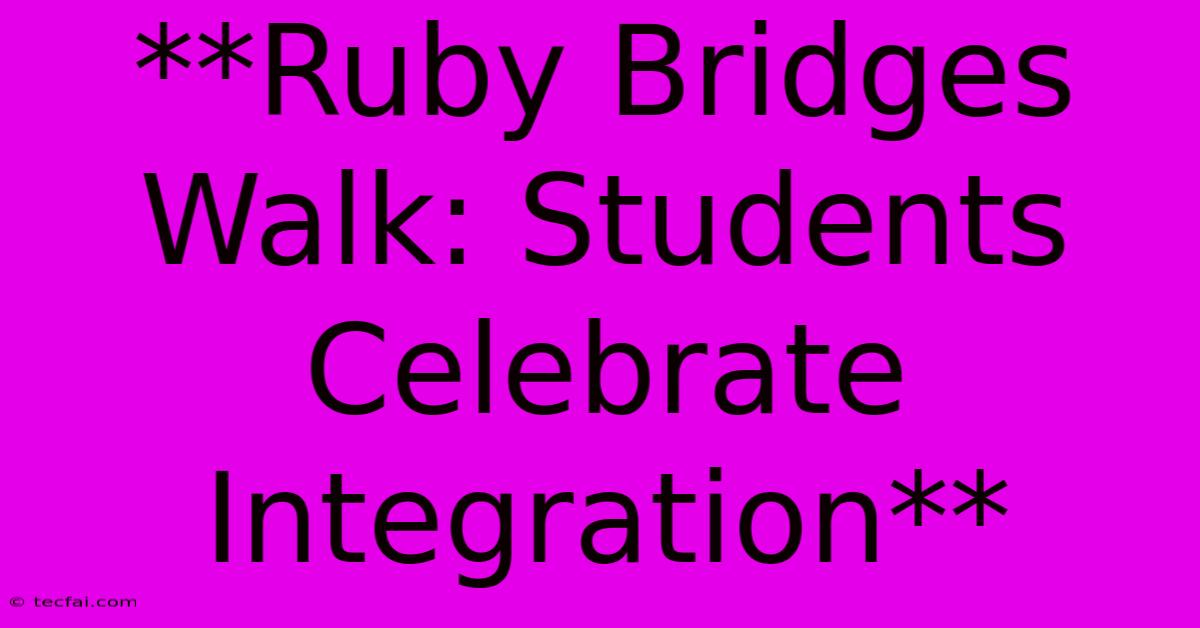**Ruby Bridges Walk: Students Celebrate Integration**

Discover more detailed and exciting information on our website. Click the link below to start your adventure: Visit Best Website tecfai.com. Don't miss out!
Table of Contents
Ruby Bridges Walk: Students Celebrate Integration
On November 14, 1960, six-year-old Ruby Bridges walked hand-in-hand with her mother into William Frantz Elementary School in New Orleans, Louisiana. This seemingly ordinary act was anything but – it marked a pivotal moment in the Civil Rights Movement, symbolizing the fight for racial equality and the end of segregation in public schools.
Today, students across the country are commemorating this historic event through the Ruby Bridges Walk, a powerful and symbolic act that aims to foster understanding, empathy, and unity. This walk serves as a reminder of the struggles faced by Ruby Bridges and countless others in their fight for equal rights and education.
The Legacy of Ruby Bridges
Ruby Bridges' story is one of immense courage and resilience. Despite facing hostile crowds and threats, she remained steadfast in her pursuit of education. She became a symbol of hope and inspiration for generations of children fighting for a brighter future.
Her journey through those school doors paved the way for integration and desegregation in schools across the United States.
The Importance of the Ruby Bridges Walk
The Ruby Bridges Walk is a powerful way for students to engage with history and connect it to their own lives. It offers a tangible experience of the challenges faced by Ruby Bridges, allowing participants to walk in her shoes, figuratively speaking.
The walk provides an opportunity for:
- Understanding: Students can gain a deeper understanding of the complexities of the Civil Rights Movement and its ongoing relevance.
- Empathy: By stepping into the shoes of Ruby Bridges, students can develop empathy for those who faced discrimination and the courage it takes to fight for justice.
- Unity: The walk encourages unity among students of different backgrounds, promoting a sense of shared history and a common goal for a more just and equitable future.
How to Organize a Ruby Bridges Walk
Organizing a Ruby Bridges Walk can be a meaningful and impactful school event. Here are some steps to consider:
- Choose a route: Select a route that is safe and accessible for all participants, potentially incorporating local landmarks or historical sites relevant to the Civil Rights Movement.
- Engage students: Involve students in planning and organizing the walk, allowing them to contribute their ideas and insights.
- Prepare educational materials: Provide students with information about Ruby Bridges, the Civil Rights Movement, and the significance of the walk.
- Promote the event: Spread the word about the walk within the school community and beyond, inviting community members to participate.
- Reflect on the experience: After the walk, encourage students to reflect on their experiences and discuss the importance of equality and inclusion.
The Power of Remembrance
The Ruby Bridges Walk is more than just a walk; it is a powerful act of remembrance, honoring Ruby Bridges' legacy and the ongoing struggle for equality. By walking in her footsteps, students can connect with history, learn from the past, and commit to building a more just and equitable future for all.
The walk serves as a reminder that even small acts of courage can have a profound impact on the world, inspiring future generations to continue the fight for justice and equality.

Thank you for visiting our website wich cover about **Ruby Bridges Walk: Students Celebrate Integration** . We hope the information provided has been useful to you. Feel free to contact us if you have any questions or need further assistance. See you next time and dont miss to bookmark.
Featured Posts
-
Beaver Moon Novembers Last Full Moon
Nov 15, 2024
-
Messi Dof Argentina Paraguay Speler Beoordelings
Nov 15, 2024
-
Paul Mescal On Men Copying His Style
Nov 15, 2024
-
Kate Garraway Sparks Fury Over Topic
Nov 15, 2024
-
Wizkid Drops New Song Kese Dance
Nov 15, 2024
